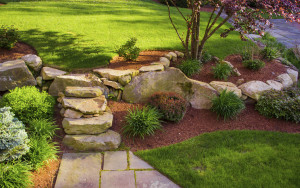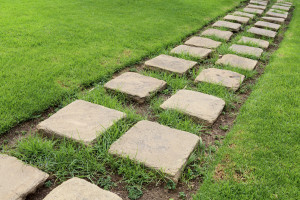GRADING AND DRAINAGE
When most people decide to undertake a landscape design project, they usually think about the bright colours that their new garden will feature. Or they think about the new interlocking patio they’ll get to enjoy.
Perhaps they’ll imagine a completely transformed garden or a brand new swimming pool of their very own.
Grading and drainage are vital to creating the backyard of your dreams

With proper grading and drainage in your backyard, you can help:
- Prevent mud pools
- Reduce stagnant water
- Lower natural garden erosion
While the stereotypical vision of grading and drainage tends to be old, rusty and bent downspouts or funnels, that don’t have to be the case it all. There are plenty of attractive and discreet options which can seamlessly integrate into your landscape construction project.
First, a closer look at grading and drainage and why they’re important.
GRADING
What is grading?

Why is it important?
Simply put, if the surface isn’t level, then the objects you build atop of it, like a flagstone walkway or natural stone steps won’t be either.
The impact of not having your property graded properly may not be evident immediately. However, over time, it will become apparent:
- Shifting or unstable structures
- Sinking or soft soil
Most importantly, if your grading is off, then water will not be able to drain properly, which leads us to…
DRAINAGE
What is drainage?
Drainage is the system which will help water flow away from your home. In many instances, drainage involves eaves troughs, gutters or downspouts catching rain.
Why is it important?

- The foundation of your house
- Driveways, walkways, patios and other stone installations
- Retaining walls
- Flooding your lawn, plants and planting
- Mosquito breeding (they breed in pooled or stagnant water)
WHAT CAN YOU DO?
Before embarking on any landscape project, you should first schedule a design consultation, and have an expert landscape contractor visit your property so they can get a better understanding of what you want – and the area that they’ll be working in.
Even if the grading and drainage issue appears to be easily solved, it pays to consult with a professional who is experienced in these matters. After all, it’s better to be aware of any potential problem before shovels get put into the ground.
CONTACT US – WE CAN HELP
Another thing you can do is request a consultation from Cedargate Landscaping. One of our design team experts will get back to you and book a date and time where we can come to you and learn more about your landscape project.
- WHY TRUST IS SO IMPORTANT TO US - December 15, 2019
- MORE ON LANDSCAPE LIGHTING - February 16, 2019
- 5 Ways Landscaping Can Increase Your Home Value - January 5, 2019
